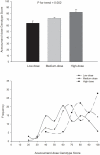A novel, single algorithm approach to predict acenocoumarol dose based on CYP2C9 and VKORC1 allele variants
- PMID: 20585445
- PMCID: PMC2887839
- DOI: 10.1371/journal.pone.0011210
A novel, single algorithm approach to predict acenocoumarol dose based on CYP2C9 and VKORC1 allele variants
Abstract
The identification of CYP2C9 and VKORC1 genes has strongly stimulated the research on pharmacogenetics of coumarins in the last decade. We assessed the combined influence of CYP2C9 *2 and *3, and VKORC1 c.-1639G>A, 497C>G, and 1173C>T variants, on acenocoumarol dosage using a novel algorithm approach, in 193 outpatients who had achieved stable anticoagulation. We constructed an "acenocoumarol-dose genotype score" (AGS, maximum score = 100) based on the number of alleles associated with higher acenocoumarol dosage carried by each subject for each polymorphism. The mean AGS was higher in the high-dose (> 28 mg/week) compared with the low-dose (< 7 mg/week) group (mean(SEM) of 84.1+/-3.4 vs. 62.2+/-4.8, P = 0.008). An AGS > 70 was associated with an increased odds ratio (OR) of requiring high acenocoumarol dosage (OR: 3.347; 95%CI: 1.112-10.075; P = 0.032). In summary, although more research is necessary in other patient cohorts, and this algorithm should be replicated in an independent sample, our data suggest that the AGS algorithm could be used to help discriminating patients requiring high acenocoumarol doses to achieve stable anti-coagulation.
Conflict of interest statement
Figures

Similar articles
-
Pharmacogenetics of acenocoumarol: CYP2C9 *2 and VKORC1 c.-1639G>A, 497C>G, 1173C>T, and 3730G>A variants influence drug dose in anticoagulated patients.Thromb Haemost. 2009 Mar;101(3):591-3. Thromb Haemost. 2009. PMID: 19277427 No abstract available.
-
Pharmacogenetics of acenocoumarol in patients with extreme dose requirements.J Thromb Haemost. 2010 May;8(5):1012-7. doi: 10.1111/j.1538-7836.2010.03800.x. Epub 2010 Feb 9. J Thromb Haemost. 2010. PMID: 20149073
-
Genotypes associated with reduced activity of VKORC1 and CYP2C9 and their modification of acenocoumarol anticoagulation during the initial treatment period.Clin Pharmacol Ther. 2009 Apr;85(4):379-86. doi: 10.1038/clpt.2008.294. Epub 2009 Feb 18. Clin Pharmacol Ther. 2009. PMID: 19225451
-
Pharmacogenetics of oral anticoagulants: a basis for dose individualization.Clin Pharmacokinet. 2008;47(9):565-94. doi: 10.2165/00003088-200847090-00002. Clin Pharmacokinet. 2008. PMID: 18698879 Review.
-
Pharmacogenetic differences between warfarin, acenocoumarol and phenprocoumon.Thromb Haemost. 2008 Dec;100(6):1052-7. Thromb Haemost. 2008. PMID: 19132230 Review.
Cited by
-
Pharmacogenetics aspects of oral anticoagulants therapy.J Med Life. 2015 Apr-Jun;8(2):171-5. J Med Life. 2015. PMID: 25866574 Free PMC article.
-
Are centenarians genetically predisposed to lower disease risk?Age (Dordr). 2012 Oct;34(5):1269-83. doi: 10.1007/s11357-011-9296-3. Epub 2011 Sep 6. Age (Dordr). 2012. PMID: 21894447 Free PMC article.
-
A Pharmacogenetically Guided Acenocoumarol Dosing Algorithm for Chilean Patients: A Discovery Cohort Study.Front Pharmacol. 2020 Apr 6;11:325. doi: 10.3389/fphar.2020.00325. eCollection 2020. Front Pharmacol. 2020. PMID: 32327994 Free PMC article.
-
Effect of CYP2C9, VKORC1, CYP4F2 and GGCX genetic variants on warfarin maintenance dose and explicating a new pharmacogenetic algorithm in South Indian population.Eur J Clin Pharmacol. 2014 Jan;70(1):47-56. doi: 10.1007/s00228-013-1581-x. Epub 2013 Sep 10. Eur J Clin Pharmacol. 2014. PMID: 24019055
-
Acenocoumarol Pharmacogenetic Dosing Algorithm versus Usual Care in Patients with Venous Thromboembolism: A Randomised Clinical Trial.J Clin Med. 2021 Jun 30;10(13):2949. doi: 10.3390/jcm10132949. J Clin Med. 2021. PMID: 34209131 Free PMC article.
References
-
- Verde Z, Santiago C, Valle B, Fernandez-Santander A, Bandres F, et al. Pharmacogenetics of acenocoumarol: CYP2C9 *2 and VKORC1 c.-1639G>A, 497C>G, 1173C>T, and 3730G>A variants influence drug dose in anticoagulated patients. Thromb Haemost. 2009;101:591–593. - PubMed
-
- Sanderson S, Emery J, Higgins J. CYP2C9 gene variants, drug dose, and bleeding risk in warfarin-treated patients: a HuGEnet systematic review and meta-analysis. Genet Med. 2005;7:97–104. - PubMed
Publication types
MeSH terms
Substances
LinkOut - more resources
Full Text Sources
Medical

